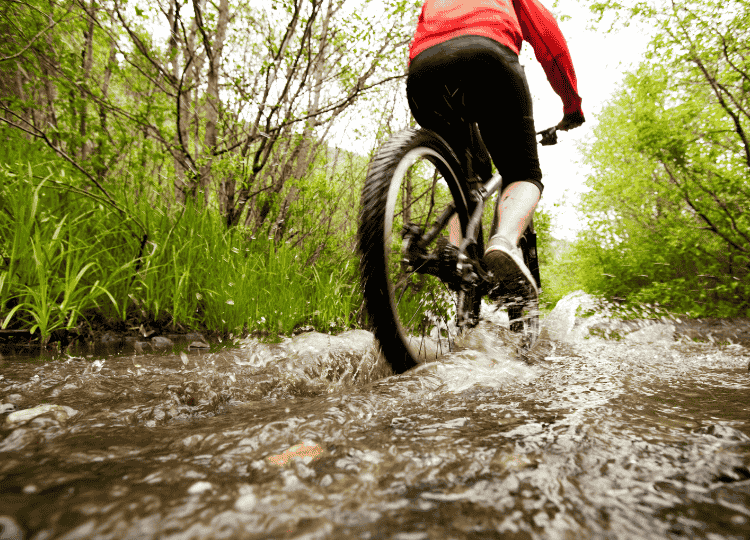No one tells you how close you are to disaster when you get caught riding your e-bike in bad weather. One moment you’re cruising, feeling on top of the world, and the next, your tires lose grip, your brakes feel spongy, and your nice ride turns into survival mode. As it turns out, bad weather and e-bikes aren’t exactly besties.
Riders who have common sense gear up with a helmet and maybe a high-vis jacket, but if the roads are slick and your battery’s acting up, will your gear keep you safe? If you’ve ever braked in the rain and kept sliding, you get it. The thing is, riding your bike in bad weather has a whole set of problems and you won’t hear a lot of people talking about them. You won’t find them in user manuals and you definitely won’t see them in ads. But that’s what we’re here for!
Keep reading to see what happens if you keep riding when the sky turns gray; we’ll also share a few handy tips that will steer you towards the safe side.
Bad Weather and Bike Performance
Getting wet will be the least of your concerns because bad weather changes how your bike behaves in ways you probably wouldn’t expect. Visibility takes a major hit, and even if your lights are on full blast, fog and heavy rain can make it nearly impossible for others to see you (at best, their vision is obscured); with ‘others’ also being drivers who likely aren’t looking out for something smaller than a car.
Reflective jackets and stickers help a little, but in low-light conditions, with rain bouncing off every surface, you can’t really count on them. And if people can’t see you, they can’t avoid you.
Then there’s the battery. Cold weather drains power faster, so if you need to be outside longer than you expected, you might not even make it back. On top of that, moisture can mess with the motor’s control system. Even waterproof bikes have weak spots, and when sensors or connectors get wet, they don’t always respond like they should. That can cause your pedal assist to cut out unexpectedly or surge when you’re not ready for it.
Braking is problematic, as well. Most e-bikes use disc brakes, which are super reliable when it’s dry outside, but with water on the rotors and pads? In these conditions, the grip is heavily reduced. It takes longer to stop, so before you head out in bad weather, make sure to check your brakes.
And let’s not forget traction. Electric bikes are heavier than regular bikes, which can be good for grip, but once those tires start to slide, it’s much harder to recover. Most stock tires aren’t made for ice or oily puddles, so even small patches of water can send you flying. And even if you prepare, bad weather increases the likelihood of crashes; that’s just how things work.
On the (unfortunate) odd chance an accident does happen, you’ll want to be familiar with your legal options following an e-bike accident, especially if the accident was caused by poor conditions on the road or reduced visibility.
How Smart Riders Take On Bad Weather
Here’s what to do when the forecast looks less than ideal.
- Treat the Forecast Like a Traffic Report
Don’t just check if it’s going to rain, you also need to know when, how much, and how fast. Check the hourly forecast and pay attention to wind speed, wind direction, and the temperature on the roads (especially in the early morning). Black ice, frost, and quick drops in temperature can turn an otherwise perfect ride into a slippery mess.
Also, know your routes – if a certain underpass floods easily, avoid it. Plan ahead to stay in control.
- Modify Your Bike Setup Beforehand
Weather affects the road, but it also affects your bike, so you can’t have the same setup year-round. When it’s cold or wet, switch to tires that grip better, like the ones with a deeper tread or ones made to be used specifically in the winter. Add longer fenders to keep the slush off your clothes and the chain cleaner. Upgrade your rear lights to something brighter and flashier to cut through fog and rain.
None of these changes take a lot of time, but they make a huge difference.
- Adjust the Way You Ride
You can’t ride the same way you would on a clear, dry day. When the weather is bad, you need to slow down so you have more time to react. Keep the fingers lightly over brake levers, avoid sharp turns, and keep your body weight centered by standing on the pedals when crossing puddles or slick patches.
- Know When Not to Ride
This is something most people overlook, but sometimes, you simply need to leave your bike at home. If the roads are icy, visibility is almost zero, or the wind is so strong it’s dangerous, the risk is simply not worth it. Cycling is super healthy, plus it’s great to be consistent. But if it’s unsafe for whatever reason, you skip the ride for the day – safety first!
Conclusion
Bad weather doesn’t have to mean a bad ride, but it always means different rules. There aren’t that many of them and really, they come down to common sense.
Once you get the hang of those few details you need to change, a little rain and fog won’t stand in the way of your ride.
